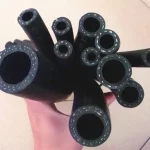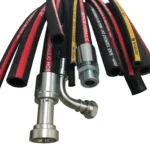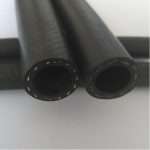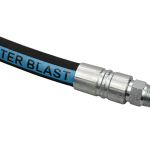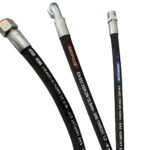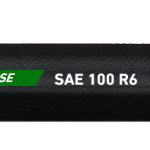As rubber technology has continued to evolve, we've seen an expansion in the variety of rubber hoses available. Despite this diversity, we commonly categorize hoses based on their pressure capabilities, dividing them into high pressure hoses and low pressure hoses. To illustrate the distinctions between high pressure and low pressure hoses, let's examine a nitrile rubber hose as our case study.
high pressure hose and low pressure hose different classification standard
If the max pressure is not higher than 1.6 MPa, it belongs to low pressure hose. While if it exceeds 10 MPa but does not exceed 100 MPa, it belongs to the high pressure tube. The one between 1.6 Mpa and 10 Mpa is a medium pressure hose. And if the max working pressure exceeds 100 MPa, it is an ultra high pressure resistant hose.
high pressure hose and low pressure hose different usage
Take the use of nitrile rubber hoses in automobile as an example. The boring pressures that high pressure nitrile hose and low pressure hose can withstand are different. Thus they are for different use. Therefore, low pressure hose is mainly for oil suction ports and belong to the input end. While the high pressure flexible hose is used at the oil delivery end. There the pressure is high to quickly output fuel to the equipment and ensure the good operation of the machinery.
High-pressure hose
We can see the application of: high-pressure hydraulic hose can be divided into high-pressure steel wire braided hose, high-pressure steel wire spiral hose, large-diameter high-pressure hose, steel wire (fiber) reinforced nylon elastomer resin tube, steel wire reinforced soft, ultra-high-pressure hose, high-temperature hose, polyurethane hose.
High-pressure steel wire reinforced hydraulic hose is mainly used in mining hydraulic support and oil field development, suitable for engineering construction and lifting transportation.
Through different applications, there are different types of hydraulic hose to choose from, because different types of hydraulic hose are also designed to make the cost lower, more suitable for use in specific hydraulic hose use occasions.
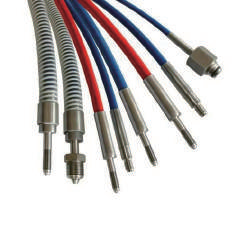
Low Pressure Hydraulic Hose
We can see the application of low-pressure hydraulic hose hose is the use of cold feeding process, hydraulic hose hose internal rubber uniformity does not deviate from the rubber, hydraulic hose hose density, the hydraulic hose hose in the rubber layer of the use of machine winding force uniformity and tight pressure. The outer rubber then into the extruder to hang the outer rubber and then water cloth machine wrapped water cloth, water cloth machine wrapped water cloth force uniformity so that the outer rubber vulcanization is completed to make the surface flat and neat. After the vulcanization is finished, lift the water cloth. Then pressurize the test to ensure that no defective products leave the factory.
And the low pressure hose of hydraulic hose is widely used in chemical industry, machinery, electronics, electrical appliances, military, aerospace, pipeline, petroleum, spinning machine, electrical insulation, environmental protection and other economic fields
Air hydraulic hose: working pressure: 0.8Mpa
Water hydraulic hose: working pressure: 0.3Mpa 0.5 Mpa 0.7 Mpa(0.3 Mpa~0.7 Mpa),
Acid and alkali resistant hydraulic hose: working pressure: 0.3Mpa 0.5 Mpa 0.7 Mpa(0.3 Mpa~0.7 Mpa), 0.7 Mpa(0.3 Mpa~0.7 Mpa), 0.7 Mpa(0.3 Mpa~0.7 Mpa).
Heat-resistant hydraulic hose: working pressure below 0.40Mpa
Oil hydraulic hose: working pressure 0.3Mpa 0.5 Mpa 0.7 Mpa(0.3 Mpa~0.7 Mpa)
Sand blasting hydraulic hose: working pressure: 0.63Mpa
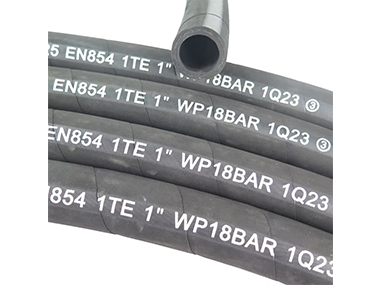
high pressure hose and low pressure hose different diameters
The design of hydraulic hose needs to consider a variety of factors, including working pressure, flow, temperature, vibration, corrosion and so on. The diameter and wall thickness of the hydraulic hose is the most critical parameter in the design, which needs to be determined according to the working pressure and flow.
Usually, the smaller the diameter of the hydraulic pipe, the higher the working pressure. Wall thickness needs to be determined according to the strength and toughness of the hydraulic pipe material, generally should ensure that the working pressure is not easy to withstand deformation and rupture.
high pressure hose and low pressure hose different technical point
The manufacturing process for high-pressure pipes is notably more intricate compared to that of low-pressure hoses.
For low-pressure hoses, simple steps such as clamping wires or incorporating a fabric layer to the structural framework suffice.
However, these techniques do not meet the requirements for high-pressure tubes, which necessitate the addition of robust materials like canvas, polyester thread, and steel wire to bolster their structure.
Sinopulse produces a wide range of high pressure hoses, ultra high pressure hose connectors, low pressure hoses and low pressure hose fitting connectors. The high or low pressure hoses we produce adhere to high quality standards to ensure that our customers can maintain a high level of safety even under high pressure. If you have any needs, please feel free to contact us!
